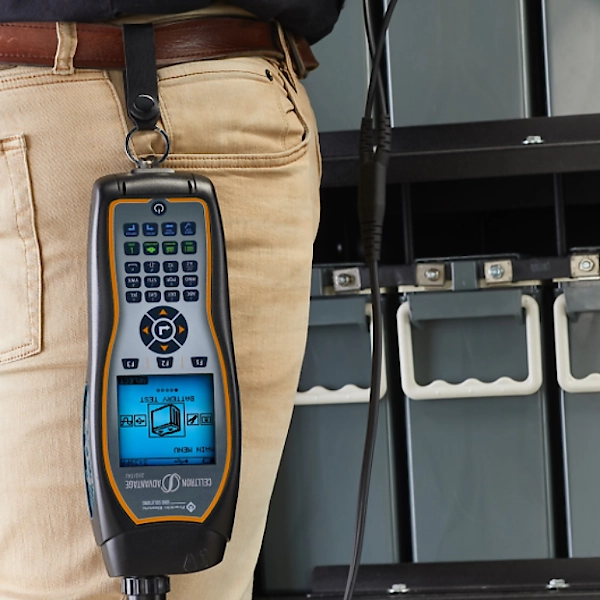Franklin Electric CADD-5500 Celltron Advantage Digital Handheld Battery Tester – Complete Kit
- CADD-5500 is the ‘Complete Kit‘ with the full accessory set
- Quick, accurate battery testing you can trust
- Originally under the branding Midtronics
The CADD-5500 is the top configuration in the Celltron Advantage range. It is a handheld, advantage digital battery tester that checks battery conductance, voltage, temperature and intercell/strap resistance in seconds, and includes extended-reach accessories for hard-to-access installations.
▶ Discover the CELLTRON Advantage!

Why the CADD-5500 is Different
Basic testers only check voltage. The CADD-5500 Celltron Advantage goes further with a full battery performance assessment using conductance-based diagnostics, plus a complete accessory bundle for faster, safer testing across dense UPS cabinets and long runs.
It measures voltage, temperature and strap resistance in high-noise environments. You get fast, clear pass/fail results. It also supports maintenance planning and compliance reporting so you can meet industry standards.
- Complete battery state analysis – including temperature and strap resistance.
- Digital signal filtering for clean, precise readings.
- Highly accurate and reliable even in high-noise areas.
- Instant results – no complex setup.
- Works with the web-based UNITE database for storing and tracking your tests.
Built for Demanding Work
The Celltron Advantage Digital Battery tester uses a dual-processor system with digital signal filtering. This gives stable, accurate readings in harsh power environments. Built-in lights on the probes make it easy to conduct a full battery test in dark areas. The robust build guarantees field-ready resilience.

Easy Data Management
Connect the CADD-5500 to the web based UNITE database. You can:
- Save unlimited test results.
- Compare past tests for trends.
- Create ready-to-use reports for compliance.
Where It Works Best
- UPS battery systems
- Utility and telecom networks
- Rail and transport power systems
- Data centres
- Generator starter batteries
What comes with the Franklin Electric CADD-5500?

- Celltron Advantage Digital Battery Tester
- Belt loop holster
- Two rechargeable battery packs
- Universal charger
- USB cable (1m)
- Protective backpack
- Free 90-day UNITE™ trial
- 4‘ interchangeable cable
- 8‘ probe cable
- Probe extenders for 4‘ and 8‘ probe cables
- Probe set with replacement tips
- Clamp set with waffle replacements
Lighted clamps/probes and extender options support confident testing in dark or hard-to-reach spaces.
Key Technical Details:
| Feature | Details |
| Voltage range | 0.8–23.5V DC |
| Conductance range | 100–19,990 Siemens |
| Accuracy | ±2% |
| Data storage | 50 strings × 240 results |
| Connectivity | Built-in Wi-Fi & USB; works with UNITE™ for maintenance planning and compliance reporting |
| Use case | Complete battery state checks even in high-noise environments; extended-reach hardware for complex installs |
Smarter Battery Care
The CADD-5500 Celltron Advantage delivers the same proven diagnostics with the most complete accessory kit - ideal when you need flexibility onsite and want to minimise retests or return visits.
Battery Testing Comparison - Make the Switch to Smarter Battery Testing
If you‘re still relying on a multimeter for battery maintenance, you could be missing hidden issues that lead to unexpected failures. The CELLTRON™ Advantage Digital provides a comprehensive, faster, and more accurate way to test batteries - helping ensure system reliability while supporting compliance with NERC and NFPA battery maintenance standards.
| Features / Benefits | Celltron Advantage Digital Handheld Battery Tester | Standard Handheld Multimeter |
| Testing Capability | Conductance testing for full battery health assessment | Voltage-only measurement |
| Speed and Efficiency | One-touch testing with instant pass/fail | Manual setup required for each reading |
| Accuracy | Advanced diagnostics detect hidden battery issues | Limited data requiring manual calculations |
| Data Management | Stores, analyses, and wirelessly transfers test results | No built-in storage, requires manual logging |
| User-Friendliness | Designed for battery professionals with clear on-screen guidance | General-purpose tool, requiring knowledge for correct setup |
| Durability | Rugged, field-ready design built for battery maintenance environments | Not specialised for battery testing conditions |
| Best For | Preventative maintenance, reducing unexpected failures | Basic voltage checks with no predictive insights |
| Full Battery Health Analysis | ✓ | X |
| Internal Ohmic Testing | ✓ | X |
| State of Charge Testing | ✓ | X |
| Intercell Connection Testing | ✓ | X |
| Instant Pass/Fail Diagnostics | ✓ | X |
| One-Touch Testing | ✓ | X |
| Automated Data Storage and Reporting | ✓ | X |
| Wireless Data Transfer | ✓ | X |
| Customisable Test Parameters | ✓ | X |
| Designed for Battery Professionals | ✓ | X |
| Reduces Human Error | ✓ | X |
| Helps Prevent Unexpected Failures | ✓ | X |
| Rugged, Field-Ready Design | ✓ | X |
| Built-In Guidance for Users | ✓ | X |
About Conductance-Based Battery Testing
Conductance-based battery testing technology measures the battery‘s conductance, which is the ability to transmit electrical current. As a battery ages or experiences degradation, its conductance changes, reflecting alterations in the internal components and overall health. Conductance-based testing allows for quick and non-invasive evaluations, enabling technicians to assess the battery status without the need for time-consuming discharge-recharge cycles.
One significant advantage of conductance-based battery testing is its ability to detect potential issues before they escalate. By providing a real-time snapshot of a battery‘s condition, this technology facilitates proactive maintenance, minimising the risk of unexpected failures. Additionally, conductance-based testing is more reliable in assessing the true state of a battery, especially in situations where voltage readings may be misleading.
- Conductance is not a measure of battery capacity; it is a measure of battery state of health
- The relationship between a battery’s capacity and conductance
- When a battery is at 60% conductance it is near end of life
As industries increasingly prioritise efficiency, safety, and sustainability, conductance-based battery testing emerges as a pivotal tool for optimising performance, extending battery life, and reducing overall operational costs. This innovative technology is proving to be a game-changer in ensuring the reliability of critical power systems across various sectors.
- Conductance is a measurement of the plate surfaces available for chemical reaction to determine how much power the battery can supply.
- The units for Conductance is MHOS (G), also known as Siemens (s)
- As batteries age, their chemical efficiency declines equaling a loss of capacity
- This loss of capacity is usually evaluated by a loss of measured conductance (it is not a one-to-one correlation)
- Conductance testing is a quick, safe, accurate and easy way to determine a battery’s relative condition or state-of-health
- High conductance is one indication of a healthy battery
- Conductance declines as the battery fails